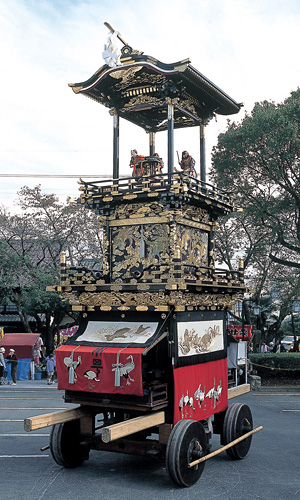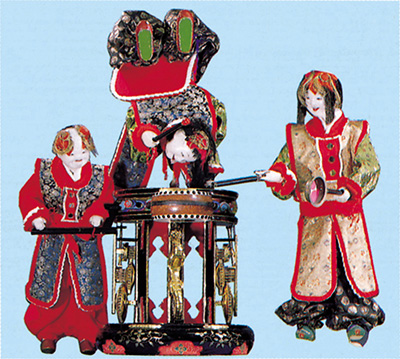 車山とからくり
車山とからくり
本町の車山

◆咸英(かんえい)
十三両中、最も豪華といわれる車山で、
上山・下山の縁板はびわ材で堆朱(ついしゅ)と呼ばれる朱漆で彫った文様があり、下山突き出しは山柿と花梨の材である。さらに、 中山の欄干は紫檀で作られている。これは明治の初頭、横浜まで出向いて一万両で購入したものと伝えられている。車山名「咸英」は、こうした高価な材料を用い、螺鈿(らでん)細工や彫金彫り物など、優れた 工芸を施した車山という意味で、「すべてに秀でる」として名付けられた。
◆Kanei Yama (Honmachi Precinct)
This yama is the most elaborate of all. The side boards of upper and lower decks are carved in red and black lacquered layers. This yama has exquisite metal inlays and pearl shell carving. The wood materials used are very expensive loquat, quince and rosewood. It is said that the materials were bought in Yokohama for ten thousand ryo (about one billion yen) in the early Meiji era. Kanei means excellence in all things.
本町のからくり人形

◆唐子遊び(からこあそび)
車山名「咸英」はすべてに秀でているという意味です。からくりは3体の唐子からなり、内2体(大人形、小人形)は糸からくりで、1体(鯱)は離れからくりで出来ています、安永3(1774)人形師「竹田藤吉」によって造られた3体の人形が織り成す優雅な唐子遊びを表現しています。このからくりの1番の見所は、鯱が中央やや前の蓮台の上で、左手片手で逆立ちをする離れからくりの技が見ものです。首尾よく逆立ちが出来ますと、首を振り右手で太鼓を打ち喜びを表します。大人形は首・身体を大きく振り鉦鐘を打ちながら行き来します。小人形は臼を廻しながら首・足を激しく動かしながら臼を廻します。3体の唐子は藤吉作の中でも顔の出来は秀でていると、研究者等から賛美を受け、特に小人形の顔は表情がすばらしいと言われています。愛知万博のポスターにも採用されました。文政7(1824)3代玉屋庄兵衛修理、平成11年(1999)9代玉屋庄兵衛修復。
◆Karako Asobi (Karako playing together)
The name of this float is Kanei which means excellence in all things.
Three karako dolls appear in the performance. Two of the karako are operated by technicians underneath using strings while the third is fully autonomous and moves on its own.
These karako were made by the famous Tokichi Takeda in 1774 who was able to give each karako its own graceful expression. The facial expressions are considered so good that they were used on a poster for the Aichi Worlds Fair Exhibition.
The highlight of this performance is that the autonomous karako does a one-handed handstand on a lotus pedestal. When he succeeds in doing the handstand he shows his joy by beating a drum with his free hand and shaking his head side to side.
The larger karako walks around while also shaking his head side to side and beating a drum to show his joy while the smaller karako pushes the pedestal around in circles.
These karako were first repaired by the 3rd Tamaya Shobei in 1824 and again by the 9th Tamaya Shobei in 1999
.